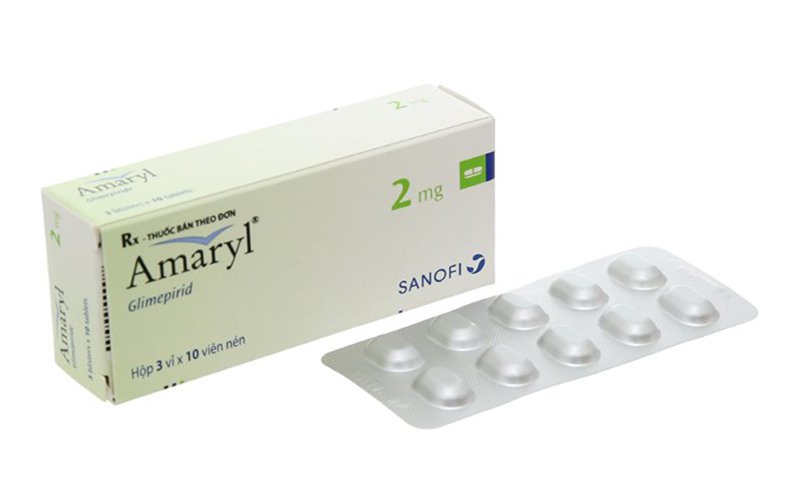Managing diabetes is a complex task that often requires a combination of lifestyle changes, dietary adjustments, and medication. Among the various medications available to control blood sugar levels, Amaryl (generic name: glimepiride) is a popular choice. In this blog post, we will delve into the details of Amaryl medication for Diabetes, exploring its mechanism of action, uses, potential side effects, and considerations for usage.
Contents
- 1 What is Amary Medication for Diabetes?
- 2 Mechanism of Action of Amaryl Medication for Diabetes
- 3 Uses of Amaryl Medication for Diabetes
- 4 Dosage and Administration of Amaryl Medication for Diabetes
- 5 Potential Side Effects of Amaryl Medication for Diabetes
- 6 Considerations and Precautions of Amaryl Medication for Diabetes
- 7 Conclusion
What is Amary Medication for Diabetes?
Amaryl is a medication used in the treatment of type 2 diabetes. Its generic name is glimepiride, and it belongs to a class of drugs known as sulfonylureas. Amaryl is prescribed to help lower blood sugar levels in individuals with type 2 diabetes. It is a condition characterized by insulin resistance and impaired insulin production.
Mechanism of Action of Amaryl Medication for Diabetes

The mechanism of action of Amaryl (generic name: glimepiride) is closely linked to its classification as a sulfonylurea, a class of medications commonly used in the treatment of type 2 diabetes. Amaryl’s primary function is to help regulate blood sugar levels by influencing insulin production and activity. Let’s explore the intricate details of how Amaryl works:
- Stimulation of Insulin Release: Amaryl acts primarily on the beta cells of the pancreas, which are responsible for producing insulin. These beta cells have specific receptors for sulfonylureas like Amaryl. When Amaryl binds to these receptors, it triggers a series of events within the beta cells.
- Closure of Potassium Channels: One key effect of Amaryl binding to its receptors is the closure of ATP-sensitive potassium channels (KATP channels) on the surface of beta cells. Normally, these channels allow potassium to flow out of the cells, causing them to become more negatively charged. Closure of these channels prevents the outflow of potassium, leading to a change in the cell’s membrane potential.
- Calcium Influx: The closure of potassium channels causes a subsequent calcium influx into the beta cells. This increase in intracellular calcium levels is a crucial step in the release of insulin.
- Insulin Granule Fusion: Elevated calcium levels within the beta cells promote the fusion of insulin-containing vesicles (granules) with the cell membrane. As a result, insulin is released into the bloodstream.
- Enhanced Insulin Secretion: The net effect of Amaryl’s action is an increased release of insulin into the bloodstream. This insulin release is glucose-dependent, meaning it occurs in response to elevated blood glucose levels. When blood glucose levels are high, Amaryl enhances insulin secretion, facilitating the uptake of glucose by cells for energy or storage.
- Insulin Sensitization: In addition to its role in stimulating insulin release, Amaryl may also improve the sensitivity of target cells (such as muscle and fat cells) to the action of insulin. This secondary effect contributes to better glucose utilization by cells. This further assists in lowering blood sugar levels.
It’s essential to note that Amaryl’s mechanism of action primarily addresses the deficiency in insulin production or release that is characteristic of type 2 diabetes. Unlike some other antidiabetic medications, Amaryl does not directly affect insulin sensitivity in the liver or muscle tissues.
Uses of Amaryl Medication for Diabetes

Beyond understanding the mechanism of action, it is important to explore the specific uses and applications of Amaryl (glimepiride) in the context of diabetes management. Here are the key uses of Amaryl medication for diabetes:
- Type 2 Diabetes Management: Amaryl is primarily prescribed for the treatment and management of type 2 diabetes. Type 2 diabetes is a metabolic disorder characterized by insulin resistance, where the body’s cells become less responsive to insulin, and impaired insulin secretion from the pancreas. Amaryl helps address this deficiency by stimulating the release of insulin.
- Blood Sugar Control: The main goal of using Amaryl is to achieve and maintain optimal blood sugar control. By enhancing insulin secretion, Amaryl facilitates the uptake of glucose by cells, reducing elevated blood glucose levels commonly observed in individuals with type 2 diabetes.
- Monotherapy or Combination Therapy: Amaryl can be used as a standalone medication (monotherapy) for individuals with mild to moderate type 2 diabetes. Additionally, it is often employed in combination with other classes of antidiabetic medications, such as metformin or thiazolidinediones, to provide a more comprehensive approach to blood sugar management.
- Mealtime Administration: Amaryl is typically taken orally, and its administration is closely linked to mealtime. It is commonly recommended to be taken with breakfast or the first main meal of the day. This is because the stimulation of insulin release by Amaryl is glucose-dependent. Taking it with a meal helps synchronize its action with the rise in blood glucose levels that occurs after eating.
- Insulin Sensitization: In addition to its primary role in stimulating insulin release, Amaryl may contribute to insulin sensitization. This means that it can enhance the effectiveness of existing insulin in the body, promoting better glucose utilization by cells.
- Individualized Treatment Plans: Healthcare providers individualize treatment plans based on factors such as the patient’s overall health, severity of diabetes, response to treatment, and potential side effects. Amaryl’s flexibility in being used as monotherapy or in combination with other medications allows for personalized approaches to diabetes management.
- Long-Term Glycemic Control: Amaryl is designed for long-term use to maintain consistent glycemic control. It is not a cure for diabetes but serves as an essential component of a comprehensive treatment plan that includes lifestyle modifications and ongoing medical supervision.
It’s important for individuals prescribed Amaryl to actively participate in their diabetes management plan, which may include regular monitoring of blood sugar levels, adherence to dietary guidelines, and engagement in physical activity.
Dosage and Administration of Amaryl Medication for Diabetes
The dosage and administration of Amaryl (glimepiride) for diabetes are crucial aspects of ensuring effective and safe treatment. The prescribed dosage can vary based on individual factors such as the severity of diabetes, response to treatment, and overall health. Here are general guidelines regarding the dosage and administration of Amaryl:
- Dosage Guidelines: The typical starting dose of Amaryl for most adults is 1 to 2 milligrams (mg) once daily. The dosage may be adjusted based on the individual’s response to treatment and the healthcare provider’s assessment of blood glucose levels. The maximum recommended daily dose is usually 8 mg, although some individuals may require higher doses in specific cases.
- Timing of Administration: Amaryl is usually taken with breakfast or the first main meal of the day. This helps synchronize the medication’s action with the post-meal rise in blood glucose levels. Taking Amaryl consistently at the same time each day promotes steady blood sugar control.
- Regular Monitoring: Regular monitoring of blood glucose levels is essential to assess the effectiveness of Amaryl and to make any necessary dosage adjustments. Furthermore, healthcare providers may recommend self-monitoring of blood glucose or periodic laboratory tests to track the response to treatment.
- Individualized Treatment Plans: The initial and maintenance doses of Amaryl are individualized based on factors such as the patient’s age, overall health, kidney function, and the presence of other medical conditions. Healthcare providers may also consider other medications the patient is taking and the potential for drug interactions.
- Combination Therapy: Amaryl can be prescribed as monotherapy (as the sole diabetes medication) or in combination with other antidiabetic medications. In cases where Amaryl alone may not provide adequate blood sugar control, healthcare providers may recommend combination therapy with other drugs like metformin or insulin.
- Missed Doses: If a dose of Amaryl is missed, it should be taken as soon as the individual remembers. However, if it is almost time for the next scheduled dose, the missed dose should be skipped, and the regular dosing schedule should be resumed. Doubling up on doses to make up for a missed one is not recommended, as it can increase the risk of hypoglycemia (low blood sugar).
- Gradual Dose Adjustments: Changes in the dosage of Amaryl should be made gradually under the guidance of a healthcare professional. It is to minimize the risk of hypoglycemia.
- Special Populations: Individuals with impaired kidney or liver function may require dosage adjustments. Their response to treatment should be closely monitored.
Potential Side Effects of Amaryl Medication for Diabetes

While Amaryl (glimepiride) is generally well-tolerated by many individuals, like any medication, it may be associated with certain side effects. It’s important for individuals using Amaryl to be aware of potential side effects. Report any unusual or severe reactions to their healthcare provider. Here are some of the potential side effects of Amaryl medication for diabetes:
- Hypoglycemia (Low Blood Sugar): One of the most common side effects of Amaryl is hypoglycemia, which occurs when blood sugar levels drop too low. Symptoms may include dizziness, shakiness, sweating, confusion, irritability, and, in severe cases, loss of consciousness. Prompt treatment with a fast-acting source of glucose is essential to raise blood sugar levels.
- Weight Gain: Some individuals may experience weight gain while taking Amaryl. This can be a result of improved glycemic control and increased storage of glucose as glycogen in the body.
- Gastrointestinal Issues: Amaryl may cause gastrointestinal side effects in some individuals. These can include nausea, vomiting, diarrhea, or stomach upset. These symptoms are usually mild and may improve over time.
- Allergic Reactions: Although rare, some individuals may experience allergic reactions to Amaryl. Symptoms of an allergic reaction may include skin rash, itching, swelling, severe dizziness, or difficulty breathing. Any signs of an allergic reaction should be reported to a healthcare provider immediately.
- Photosensitivity: Amaryl may increase sensitivity to sunlight, leading to an increased risk of sunburn. Individuals taking Amaryl should take precautions, such as using sunscreen and protective clothing, to avoid excessive sun exposure.
- Liver Function Abnormalities: In rare cases, Amaryl has been associated with liver function abnormalities. Routine monitoring of liver function may be recommended, and individuals should report any symptoms of liver problems, such as jaundice (yellowing of the skin and eyes) or persistent nausea.
- Blood Disorders: Amaryl, like some other medications, may rarely be associated with blood disorders. Changes in blood cell counts should be monitored, and any unexplained bruising or bleeding should be reported to a healthcare provider.
- Vision Changes: Some individuals may experience changes in vision while taking Amaryl. Reporting any vision abnormalities to a healthcare provider for further evaluation is important.
It’s crucial to note that not everyone using Amaryl will experience these side effects, and the severity and occurrence of side effects can vary among individuals.
Considerations and Precautions of Amaryl Medication for Diabetes
While Amaryl (glimepiride) is an effective medication for managing type 2 diabetes, there are several considerations and precautions that individuals and healthcare providers should be mindful of. This is to ensure safe and optimal use:
- Patient Education: Healthcare providers should educate patients on the importance of regular monitoring of blood glucose levels. This helps assess the effectiveness of Amaryl and allows for appropriate dosage adjustments to avoid hypoglycemia or hyperglycemia.
- Liver and Kidney Function: Individuals with impaired liver or kidney function may require dosage adjustments. Regular monitoring of liver and kidney function is often recommended to ensure the safe use of Amaryl.
- Pregnancy and Breastfeeding: The safety of Amaryl during pregnancy and breastfeeding has not been well-established. Pregnant or breastfeeding individuals should consult with their healthcare provider before using Amaryl. Furthermore, in some cases, alternative medications or insulin may be considered.
- Elderly Population: Elderly individuals may be more sensitive to the effects of Amaryl, and lower initial doses may be considered. Close monitoring for hypoglycemia is crucial in this population.
- Alcohol Interaction: Amaryl may interact with alcohol, potentially leading to an increased risk of hypoglycemia. Patients should be advised to limit alcohol consumption and discuss their alcohol use with their healthcare provider.
- Surgery and Stressful Situations: During periods of surgery, illness, or other stressful situations, blood glucose levels may be harder to control. Furthermore, In such cases, healthcare providers may adjust Amaryl dosages or temporarily switch to insulin therapy.
Conclusion
Amaryl is a valuable medication in the management of type 2 diabetes. It offers a mechanism of action that enhances insulin release and sensitivity. As with any medication, it’s essential to use Amaryl under the guidance of a healthcare professional, adhering to prescribed dosages and closely monitoring for potential side effects. Regular communication with a healthcare provider ensures that the treatment plan remains effective and suits the individual’s unique health needs. Always consult with a healthcare professional for personalized advice based on your specific health condition and medical history.
Do you want to get rid of diabetes? Join our online diabetes treatment program and reverse Diabetes naturally through lifestyle changes such as a Personalized Diet plan, Exercise, Yoga, dieticians, and health coaches.

